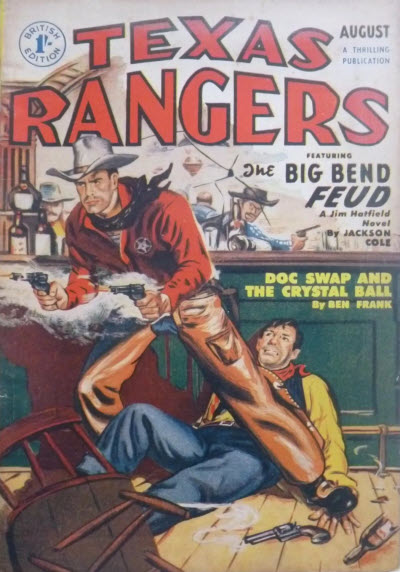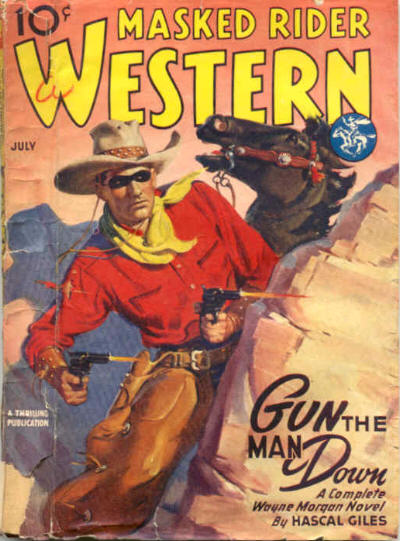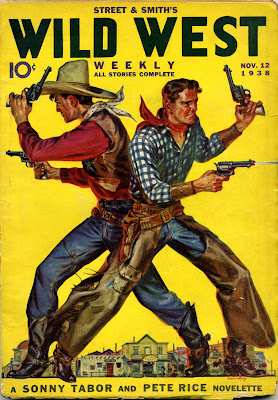Intimations and Coincidences
In a recent blog entry, Doug Wilson pondered the potential significance of some coincidences that cropped up recently in his reading. I’ve had the same experience more than once, though, like Doug, I don’t know what weight or significance to attach to these experiences. They’re certainly not all profound or obviously meaningful.
 The other day, just for the fun of it, I was reading a book about the old pulp magazines, which generated a blog entry on westerns and another on the amount of writing some pulp writers did and how much they were paid for it.
The other day, just for the fun of it, I was reading a book about the old pulp magazines, which generated a blog entry on westerns and another on the amount of writing some pulp writers did and how much they were paid for it.
In a chapter on the pulp hero named Operator # 5, there was a discussion of the novels in this series about the invasion of the United States by the Purple Empire, headed up (of course) by the Purple Emperor. There’s a picture of the first of those pulp novels to the right.
I set that book down and picked up Kenneth Grahame’s Pagan Papers (a dud, by the way; stick to his The Wind in the Willows and The Reluctant Dragon) and what should I find at the end of an essay on getting a bookbinder to put expensive bindings on your books? These words: “For these purple emperors are not to be read in bed, nor during meals, nor on the grass with a pipe on Sundays; and these brief periods are all the whirling times allow you for solid serious reading. Still, after all, you have them; you can at least pulverise your friends with the sight; and what have they to show against them?”
Two occurrences of the phrase “purple emperor” in the space of a few minutes. I’d understand that if either of these books was about butterflies (and I suppose Grahame may be making a metaphorical allusion to the purple emperor butterflies, though the allusion is not entirely clear to me). But what are the chances of finding that precise and unusual combination of words twice in two very different books, neither of them about butterflies, in the space of fifteen minutes? A big coincidence, certainly, but intimating … what, exactly? Probably nothing. Certainly nothing clearly. But then, why the noticeable coincidence?
Faster Than a Speeding … Pulp Writer?
In my last post, I mentioned The Waltons, a show that comes easily enough to my mind because I’m working my way through Season 4 right now with my family. Speaking of Season 4, in the fourth episode (“The Prophecy”), John-Boy is confronted by a professor who tells him that he’ll be very lucky if he can make a living as a writer. He says something like “There are only half a dozen writers in the United States right now who are able to do it.”
Perhaps he was referring only to what might be termed “serious literature,” which seems to be what John-Boy wants to write. (The creator of The Waltons, somewhat disappointingly, seems to have turned out only about three novels himself.) But if John-Boy had wanted to write for the pulps, he might just have been able to make a living. If he had been fast enough.

“Come now,” you say. “Surely the pulps didn’t pay that well.” Granted. They might pay a penny a word (as with the Texas Rangers series I mentioned in my previous blog entry) or perhaps $500 for a novel. Lester Dent, working under the house name Kenneth Robeson, started writing the Doc Savage novels at $500 a month and later received $750. The magazines themselves didn’t cost very much — maybe a dime — but some of them had a lot of readers. Within a couple of years from its first issue, The Shadow “was selling more than 300,000 copies” (Hutchison, The Great Pulp Heroes, 20). At a dime an issue, that’s $30,000 per month. Not bad, considering it was the Great Depression.
What kind of wages might a writer earn? That would depend on how many stories he sold, and that might depend on how fast he wrote. According to this site, wages in the early ’30s ranged from $0.35 an hour to $1.50 an hour (e.g., for a doctor). At an average of 21.67 working days a month and assuming only eight working hours a day, that’s $60.68 to $260 a month. Lester Dent’s $500 a month looks pretty good in comparison, doesn’t it?
But then consider a guy like Walter Gibson, who wrote The Shadow novels under the name Maxwell Grant. At first, he was writing only one novel a quarter, but soon it was a novel a month — and then the magazine started to come out twice a month: “he was to produce twenty-four adventures per year, one 60,000-word novel every two weeks for as long as the popularity of The Shadow continued. That figure totaled more than 1,440,000 words per year” (20).
 If you do the math, that’s 692 words an hour, every hour, eight hours a day and 21.67 days a month, every month. Not 692 first draft, sloppy, “I’ll write them fast and edit them later” words. That’s finished product, ready to go. And that’s not 692 words per hour, after taking some time to think about your plot. If Gibson took some time for plotting, the actual writing was a lot quicker.
If you do the math, that’s 692 words an hour, every hour, eight hours a day and 21.67 days a month, every month. Not 692 first draft, sloppy, “I’ll write them fast and edit them later” words. That’s finished product, ready to go. And that’s not 692 words per hour, after taking some time to think about your plot. If Gibson took some time for plotting, the actual writing was a lot quicker.
And, in fact, it was: “Keeping two dozen yarns ahead of publication, he sometimes turned out a fresh book in four to six days, often working all night to meet self-imposed deadlines. Behind a typewriter, he was as superhuman as his own creation. He worked on a battery of machines. When one began to “get tired,” he’d move on to another, and then to a third (20).”
And he kept it up for eighteen years, for a total of 283 Shadow novels … among other things. Hutchison notes that the published guide to Gibson’s writing “is, in itself, a staggering 328 pages long” (29), and included “149 other books of all types, thousands of newspaper and magazine pieces, comics, radio shows, puzzles, mgic tricks, and other material under various pen names” (29).I don’t know what his income was per story. If he was paid a penny a word, that comes to $1200 a month. Maybe, like Dent, he received $500 a novel, but that still comes to $1000 a month — and that at a time when many doctors were making less than $300 a month.
Serious literature, John-Boy? No, you couldn’t likely have made a living writing that in those years of the Great Depression on Walton’s Mountain. But if you’d been writing for the pulps your father liked to read and if you wrote fast enough and well enough, maybe you could have. Apparently some people did.
Westerns
It’s hard to imagine, but according to pulp magazine historian Don Hutchison, from the 1930s into the ’50s, there were at least “184 separate magazines devoted exclusively to Western fiction”:
In magazines with titles like Blazing Western, Wild West Weekly, and Western Round-Up, legions of dusty Galahads blasted six-gun trails to pulpwood glory. Vast and forbidding, the landscape of the American frontier produced one of the most alluring blank canvases in popular culture. Pulp Westerns, with their visions of high adventure and idyllic romance set in that perilous dream world, gloried in the nostalgic appeal of the uncivilized — total escape from anything that might be crowding you. They spoke beguilingly to the homebound reader of men and women with civilization at their backs who were never afraid and never bored” (The Great Pulp Heroes, 149).
Consider what sort of demand there must have been to make it worth a publisher’s while to put out just one of these magazines every week or even every month, year after year.
Then imagine how many voracious readers there must have been to gobble up 184 different magazines. (One of them was John Walton; true to real life, in many episodes of The Waltons, you see him reading a pulp Western magazine.)

 Granted, some of those magazines probably folded after an issue or two. But others of them lasted for years. There were, for instance, Texas Rangers magazine published 206 novels about Texas Ranger Jim Hatfield in a series that lasted from 1936 to 1958 — and that, mind you, in spite of the dialogue, of which Hutchison says, “Some Western writers of the twenties and thirties considered it necessary to inflict painful cowboy slang and dialect on readers, as if their characters had studied under Gabby Hayes’ demented speech coach. Apparently, this was the way you were supposed to talk if you lived west of St. Louis” (151).
Granted, some of those magazines probably folded after an issue or two. But others of them lasted for years. There were, for instance, Texas Rangers magazine published 206 novels about Texas Ranger Jim Hatfield in a series that lasted from 1936 to 1958 — and that, mind you, in spite of the dialogue, of which Hutchison says, “Some Western writers of the twenties and thirties considered it necessary to inflict painful cowboy slang and dialect on readers, as if their characters had studied under Gabby Hayes’ demented speech coach. Apparently, this was the way you were supposed to talk if you lived west of St. Louis” (151).
Mind you, the magazines that were most successful were not necessarily the ones you might have expected:
Despite his radio and comic strip fame, The Lone Ranger’s own magazine lasted but eight issues while his blatant pulp clone, the Masked Rider (who wore a mask and palled around with an Indian companion named Blue Hawk), galloped on for over one hundred numbers. Go figure (149).

.jpg)